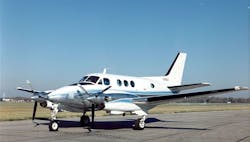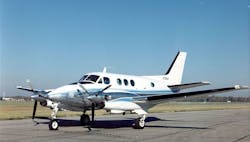UAS collides with passenger aircraft on approach to airport in Quebec City
QUÉBEC. The Transportation Safety Board (TSB) of Canada is investigating the collision between an unmanned aircraft system (UAS), also known as a drone, and a passenger aircraft, specifically a twin turboprop, that took place on approach to the Jean Lesage International Airport in Québec City on 12 Oct. 2017.
On 12 October 2017, a Beech King Air A100 operated by Skyjet M. G. was on an instrument flight rules flight from the Rouyn-Noranda (Quebec) airport (CYUY) to the Jean Lesage International Airport (CYQB) in Québec City, Quebec, with two crew members and six passengers on board.
The aircraft was approaching runway 24 and had just passed the final approach fix when the crew noticed a drone – an unmanned aerial vehicle (UAV) – at the extremity of the left wing. The aircraft struck the UAV at an altitude of 1500 feet and the crew declared an emergency.
Aircraft rescue and firefighting services were deployed and the aircraft safely landed on runway 24. The aircraft inspection revealed a few scratches and some paint transfer on the top surface of the left wing and scrape marks on the de-icing boot. The aircraft was then returned to service. No one was injured.
The TSB is an independent agency that investigates marine, pipeline, railway and aviation transportation occurrences. Its sole aim is the advancement of transportation safety. It is not the function of the Board to assign fault or determine civil or criminal liability.
The King Air civil utility aircraft was the first aircraft in its class and has been in continuous production since 1964, according to Wikipedia. It has outsold all its turboprop competitors combined and now faces competition from jet aircraft, such as the Embraer Phenom 100, Honda HA-420 HondaJet, and Cessna Citation Mustang, as well as from newer turboprop aircraft including the Piaggio P180 Avanti, and single-engine Piper Malibu Meridian, Pilatus PC-12, and Socata TBM.
Search the Aerospace & Defense Buyer's Guide
The go-to resource for Intelligent Aerospace technology news & information:
Covering key topics
Across all market segments
Subscribe to the free Intelligent Inbox e-newsletter
Subscribe to receive all the latest aerospace technology news & information, delivered directly to your e-mail inbox twice a week (Tuesdays and Thursdays). Sign upfor your free subscription to the Intelligent Inbox e-newsletter at http://www.intelligent-aerospace.com/subscribe.html.
Connect on social media
Keep pace with aerospace innovation and opportunities via your favorite social media channels. Connect with Intelligent Aerospace on Twitter (@IntelligentAero), LinkedIn,Google+, and Instagram.


